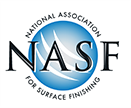NASF Provides Technical Input to Danish EPA on Nickel Coatings
The NASF has provided information on nickel-free coatings and the use of nickel in coatings for a project for the Danish EPA.
The Danish EPA is working on a project for nickel-free coatings, particularly with respect to jewelry, piercings, watches, eyeglasses, buttons, buckles, zippers, electronics and tools. NASF provided information on nickel-free coatings and the use of nickel in coatings. For many critical applications such as for aerospace and defense, nickel-free coatings are not yet an option, but these applications were beyond the scope of the Danish EPA project.
For most applications on articles with direct dermal contact, nickel-free layers of coatings have been used successfully, including bronze alloys, palladium, and palladium-nickel (low nickel). All of these coatings would comply with the nickel release restrictions of 0.5 µg/cm2/week. Nickel can also be used as a lower layer of coatings, but would not have dermal contact and would not leach through the other top layers.
Organic top coats or cataphoretic lacquers can be used to minimize dermal contact for other nickel components, but these vary in durability and would not be used in jewelry, body piercings, or other articles with direct dermal contact. Typically, these organic top coats would be used in handbags, decorative emblems, hooks and other similar type products. It is often difficult to determine the precise durability of these coatings (particular in comparison to metal top coats), but additional information on the durability tests used were provided.
The next steps in the Danish project included a preliminary report and testing of products to determine if they contain nickel or have nickel in coatings. The Danish EPA would be developing additional reports as they continue to gather data over the next few months. Brad Durkin of Coventya and Mark Schario of Columbia Chemical provided technical assistance on the effort. NASF plans to continue its dialogue with the Danish representatives and provide additional technical information as needed.

This update is courtesy of the National Association for Surface Finishing (NASF). For more information or to become a member, visit nasf.org.
Related Content
-
Practical Environmental Management Reduces Costs, Refines Quality
By focusing on effluent treatment and efficient tin recovery, this Indian surface treatment plant meets stringent environmental standards and sustainable high-quality production.
-
Hexavalent to trivalent chromium — the environmental benefits
Regulatory pressures to switch from hexavalent chromium to trivalent alternatives are a growing concern for many finishing operations. In this Products Finishing Ask the Expert clinic, Brittany McKinney of Pavco discusses the environmental considerations driving these regulations.
-
Anode Answers for Hard Chrome Plating
While problems continue to rise with using lead anodes for hard chrome plating, some manufacturers are discovering platinized titanium anodes as a much-improved alternative with a long list of advantages.















